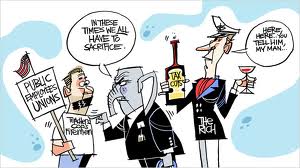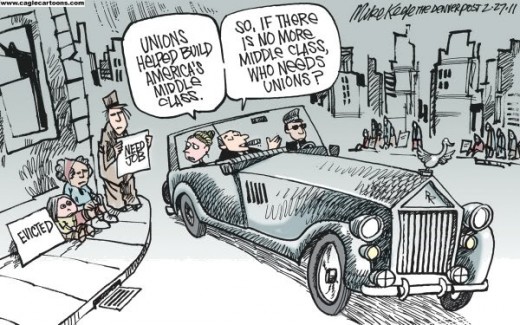The Role of the Union in Communication *quick Update*

Are unions relevant in today’s America?
Shaping Communication
The role of the union in communication is to shape the way both employees and employers interact. This role of the union can be direct by way of contract or indirect. Communication between an employer and employee within a company is to convey information that can benefit the company. This information can range from simple instructions to complicated procedures requiring not just verbal communication but precise written instructions. Communication depends on the type of job, the size of the company, and if the company is unionized. Unions have a strong influence on the interactions between employees, employers, and individual employees.
Working for the union or company
In a company doing well, communication between the employer and employee is usually civil. A company making a profit or with satisfied customers will be willing to treat their employees with greater respect than a company in crisis (this is if the employee is following company protocol). If an employee is happy with the company he or she works for, they tend to be a productive employee. The exception to this is a company that has a union. An employee in a union can be left with the idea that he or she works for the union and not the company.
Employee Employer Hierarchy
Unions create a unique setting for communication between the employer and employee. According to Randall G. Holcombe, the loss of the unions and government intervention is hurting both economic growth and freedom (Holcombe, 2010). Unions help with the growth of the economy as long as they are not restricted or enabled by legislation.
Within most factories, the group dynamic is a hierarchy; A level in which both title and seniority determine a person's place within the group. With a union, job placement is set and defined. This is to protect the worker.
Foreman and Stewards
Unionized companies, as well as non-union companies, will have a person in charge as a direct spokesman for the company. This is usually in the form of a shift leader or foreman. This foreman’s job is not only to maintain production but also to enforce company policy as negotiated by the union contract or as set by the company. He or she has to police their workers looking for infractions. The foreman’s job satisfaction can be influenced by the amount of his or her identification with management (Halperm, 1961). This policing creates resentment in the workers against the foreman. The view of their employees influences his or her job satisfaction.
Any communication within a unionized form of group dynamic must go through the onsite union representative, sometimes known as a shop steward before or at the same time the information is given to the employee. Verbal communication is limited and only allowed with a union representative present. Most information is in writing, a written account of any reprimands or accusations made against the employee that could later be used to fire the employee. The effect this is that many employees, the only contact with the company, comes in the form of reprimands with little to no praise. Foreman who praise the employees under them tends to have more productive shifts than the foreman who do nothing but scream at the workers.
Miscommunications cost money
A union contract strictly regulates the communication between union workers and non-union workers. This is to ensure that any agreements made follow guidelines. Small unionized companies to prevent any miscommunication may require all communication, whether office personnel or factory personnel follow the requirements set by the union contract. This includes all work-related communication between personnel must be in written form. This does not include phone messages, non-work-related communication, queries on work in progress, or information regarding the company’s finances.
This also helped with the ongoing problem of sexual harassment between the office assistants and the foreman. For years the foreman would come under the guise of needing a question of the sales department and spend 30 to 40 minutes speaking to one of the office assistants on personnel matters not related to work. In some cases, questions were of a personnel nature of her intimate relations with her first boyfriend later husband. The company would not speak to the foreman in question, but by requiring all items to be in the form of a written memo, the foreman no longer had a reason to enter the office. At first, this created chaos with the non-union office personnel not being able to able to go to another office and ask a question about a business matter, eventually having everything in writing reduced misunderstandings. The new policy helped create a set of books that became a “How to” for any work-place procedure. This eliminated mistakes that happened in the past, costing the company money.

Union a long term partnership
A common dilemma for unionized workers is the popular (especially in politics) idea that unions are finite. Long term unions only serve outside parties such as political parties and organized crime. This is allegorist to President Jefferson, the US Navy, and the war of 1812. When elected, Jefferson worked to eliminate the standing army, including the plans to build up the navy. This reduced the Navy to mostly a coastal defense with small gunboats that could not hope to stand up to the British. A union needs to endure to protect the hard-earned terms won by the employer. Companies are out to make profits. Money spent on employees cuts into perceived profits.
Company and union working together
Unions can create new ways in which union and non-union employees interact with each other. A companies rules set for the union, employee interactions are used for all employees. Among the rules are all company communications are to be in a written form, so there will be a record. This includes reprimands that are on file, as well as any instructions given to an employee on a job. A written account may reduce miscommunications by reducing verbal interactions between the union and non-union employees. This written communication rule can hinder a dynamic workflow. A balance between the need for procedures and workflow will require companies and unions to compromise or risk the loss of all.
Should Unions evolve with the times?
References
Halperm, R. S. (1961). Employee Unionization and Foremen's Attitudes.
Holcombe,, R. G. (2010). UNIONS, ECONOMIC FREEDOM, and GROWTH. CATO Journal
© 2013 Michael Collins aka Lakemoron








